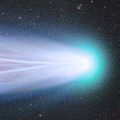
|
It brightened up to 3 mag in outburst on Dec. 14. Then several small outbursts occured repeatedly, and the comet has been fading gradually. But it is bright as 6.8 mag still now (Jan. 13, Chris Wyatt). In the Southern Hemisphere, it stays observable in the extremely low sky for a while. In the Northern Hemisphere, it is already unobservable. It will become observable again at 13 mag in late April.
Date(TT) R.A. (2000) Decl. Delta r Elong. m1 Best Time(A, h)
Jan. 22 21 39.38 -36 20.1 1.504 0.736 24 8.1 18:46 ( 54,-12)
Jan. 29 21 35.93 -36 5.7 1.660 0.824 21 8.8 18:52 ( 58,-18)
|
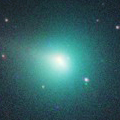
|
Now it is bright as 9.3 mag (Jan. 7, Michael Jager). It stays bright as 9-10 mag until March. In the Northern Hemisphere, it stays observable in excellent condition for a long time. In the Southern Hemisphere, it will be extremely low in February.
Date(TT) R.A. (2000) Decl. Delta r Elong. m1 Best Time(A, h)
Jan. 22 1 2.37 -2 59.6 1.229 1.313 71 8.9 18:46 ( 40, 45)
Jan. 29 1 18.62 2 5.4 1.253 1.307 70 8.9 18:52 ( 49, 46)
|
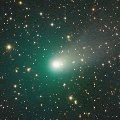
|
Now it is 9.3 mag (Jan. 6, Marco Goiato). It stays bright as 10 mag until spring for a long time. It stays observable in good condition for a long time. It locates somewhat low in the Southern Hemisphere,
Date(TT) R.A. (2000) Decl. Delta r Elong. m1 Best Time(A, h)
Jan. 22 6 51.95 28 49.7 2.620 3.556 158 9.9 22:45 ( 0, 84)
Jan. 29 6 46.34 27 23.0 2.664 3.559 151 9.9 22:12 ( 0, 82)
|
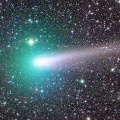
|
Now it is very bright as 9.5 mag (Jan. 6, Carlos Labordena). It stays observable in good condition for a long time. It locates somewhat low in the Southern Hemisphere,
Date(TT) R.A. (2000) Decl. Delta r Elong. m1 Best Time(A, h)
Jan. 22 8 39.78 29 10.0 0.581 1.559 169 10.0 0:37 ( 0, 84)
Jan. 29 8 33.25 29 0.8 0.632 1.609 168 10.3 0:03 ( 0, 84)
|
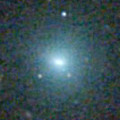
|
Brightened very rapidly. Now it is very bright as 10.1 mag (Jan. 20, Osamu Miyazaki). It is observable at 10 mag in good condition until February.
Date(TT) R.A. (2000) Decl. Delta r Elong. m1 Best Time(A, h)
Jan. 22 1 33.60 0 54.3 0.642 1.082 80 10.1 18:46 ( 32, 52)
Jan. 29 2 7.31 3 17.1 0.639 1.098 82 10.3 18:52 ( 34, 54)
|
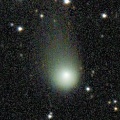
|
Now it is bright as 11.7 mag (Jan. 11, Osamu Miyazaki). It is expected to be observable at 5-6 mag for a long time from 2022 to 2023. In the Northern Hemisphere, it stays observable in good condition until autumn. However, it is not observable at the high light from autumn to 2023 summer. In the Southern Hemisphere, it will be observable after February. Then it will be observable in good condition at the high light.
Date(TT) R.A. (2000) Decl. Delta r Elong. m1 Best Time(A, h)
Jan. 22 18 14.47 12 3.6 4.865 4.207 43 10.7 5:37 (272, 25)
Jan. 29 18 19.91 11 47.4 4.759 4.144 46 10.6 5:34 (275, 28)
|
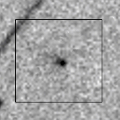
|
In the Northern Hemisphere, it stays extremely low until spring. In the Southern Hemisphere, it stays observable at 11 mag until June.
Date(TT) R.A. (2000) Decl. Delta r Elong. m1 Best Time(A, h)
Jan. 22 17 56.37 -20 54.8 2.392 1.650 32 11.8 5:37 (302, 8)
Jan. 29 18 18.89 -20 58.6 2.342 1.627 34 11.6 5:34 (303, 8)
|
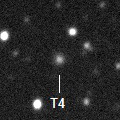
|
Now it is 12.5 mag (Jan. 2, Marco Goiato). It will brighten up to 11.5 mag in spring. It stas observable in good condition for a long time.
Date(TT) R.A. (2000) Decl. Delta r Elong. m1 Best Time(A, h)
Jan. 22 12 7.32 -29 40.0 4.030 4.395 105 12.1 4:03 ( 0, 25)
Jan. 29 12 8.06 -29 30.6 3.920 4.380 111 12.0 3:37 ( 0, 25)
|
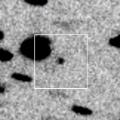
|
Now it is 14.9 mag (Jan. 4, Ken-ichi Kadota). It will brighten up to 12 mag from winter to spring.
Date(TT) R.A. (2000) Decl. Delta r Elong. m1 Best Time(A, h)
Jan. 22 16 40.17 -18 28.3 2.029 1.598 50 12.5 5:37 (314, 22)
Jan. 29 17 2.00 -19 34.8 1.976 1.582 52 12.4 5:34 (315, 21)
|
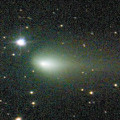
|
It brightened up to 10.6 mag in autumn (Oct. 10, Osamu Miyazaki). Now it is fading. But it is still bright as 12.1 mag (Jan. 11, Osamu Miyazaki). It stays observable in good condition for a long time.
Date(TT) R.A. (2000) Decl. Delta r Elong. m1 Best Time(A, h)
Jan. 22 6 21.87 9 4.2 1.180 2.093 150 12.6 22:15 ( 0, 64)
Jan. 29 6 20.35 9 46.3 1.256 2.134 144 12.9 21:46 ( 0, 65)
|

|
Now it is 16.7 mag (Jan. 20, Jean-Francois Soulier).
Date(TT) R.A. (2000) Decl. Delta r Elong. m1 Best Time(A, h)
Jan. 22 4 16.26 30 15.2 5.326 5.951 125 13.4 20:10 ( 0, 85)
Jan. 29 4 15.63 30 1.4 5.423 5.953 118 13.5 19:42 ( 0, 85)
|
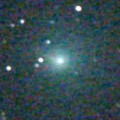
|
Now it is bright as 11.3 mag (Jan. 3, Chris Wyatt). It will be fading rapidly after this, and it will be fainter than 18 mag in March.
Date(TT) R.A. (2000) Decl. Delta r Elong. m1 Best Time(A, h)
Jan. 22 0 45.22 -13 38.0 2.135 1.928 64 13.7 18:46 ( 37, 33)
Jan. 29 1 0.35 -11 45.6 2.242 1.977 61 14.3 18:52 ( 43, 32)
|

|
Now it is 15.1 mag (Dec. 14, Chris Wyatt). It will brighten up to 13 mag in spring. In the Southern Hemisphere, it stays observable in good condition for a long time. In the Northern Hemisphere, it is not observable until autumn.
Date(TT) R.A. (2000) Decl. Delta r Elong. m1 Best Time(A, h)
Jan. 22 12 22.91 -60 51.5 3.372 3.436 85 14.0 4:19 ( 0, -6)
Jan. 29 12 7.32 -63 30.4 3.273 3.409 89 13.9 3:37 ( 0, -9)
|

|
It brightened up to 12.3 mag from spring to summer (June 15, Marco Goiato). Now it is fading. It has already faded down to 14.9 mag (Jan. 1, Toshihiko Ikemura, Hirohisa Sato).
Date(TT) R.A. (2000) Decl. Delta r Elong. m1 Best Time(A, h)
Jan. 22 14 26.99 8 10.1 4.102 4.219 90 14.0 5:37 (336, 61)
Jan. 29 14 24.80 9 43.6 4.012 4.257 97 14.0 5:34 (349, 64)
|
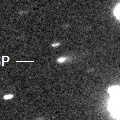
|
Now it is 14.5 mag (Jan. 12, Michael Jager). It will brighten rapidly, and it will be observable at 13.5 mag in good condition from winter to spring.
Date(TT) R.A. (2000) Decl. Delta r Elong. m1 Best Time(A, h)
Jan. 22 10 4.88 17 14.8 1.583 2.505 153 14.5 2:02 ( 0, 72)
Jan. 29 10 0.96 17 38.6 1.528 2.483 161 14.3 1:30 ( 0, 73)
|
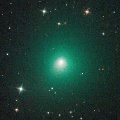
|
It brightened up to 9.5 mag in early summer (June 27, Marco Goiato). Now it is fading. It has faded down to 12.7 mag in autumn (Nov. 22, Thomas Lehmann). Now it is not observable. In the Southern Hemisphere, it will appear in the morning sky at 15 mag in late February. In the Northern Hemisphere, it is not observable until June when the comet will fade down to 17 mag.
Date(TT) R.A. (2000) Decl. Delta r Elong. m1 Best Time(A, h)
Jan. 22 20 22.00 -33 0.3 3.987 3.037 13 14.4 18:46 ( 65,-23)
Jan. 29 20 35.44 -32 48.1 4.034 3.093 14 14.6 5:34 (294,-24)
|
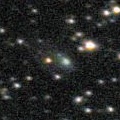
|
Now it is 14.9 mag (Nov. 28, Thomas Lehmann). It is expected to brighten up to 11 mag from spring to summer. In the Southen Hemisphere, it is not observable until February, but it stays observable in good condition for a long time after that. In the Northern Hemisphere, it is hardly observable after this.
Date(TT) R.A. (2000) Decl. Delta r Elong. m1 Best Time(A, h)
Jan. 22 19 35.75 -10 43.7 3.448 2.500 13 14.7 5:37 (279, -5)
Jan. 29 19 42.58 -11 52.3 3.372 2.442 16 14.5 5:34 (283, -2)
|
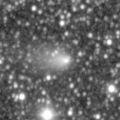
|
It brightened up to 11.5 mag in outburst in October (Oct. 22, Marco Goiato). Now it is fading. It has already faded down to 14.1 mag (Jan. 1, J.-G. Bosch, F. Kugel, J. Nicolas). In the Southern Hemisphere, it is already unobservable. In the Northern Hemisphere, it stays observable until early February.
Date(TT) R.A. (2000) Decl. Delta r Elong. m1 Best Time(A, h)
Jan. 22 22 27.78 -8 59.3 2.671 1.931 33 14.6 18:46 ( 68, 14)
Jan. 29 22 44.33 -7 27.9 2.737 1.960 30 14.9 18:52 ( 72, 12)
|
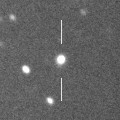
|
Now it is 13.8 mag (Jan. 7, Toshihiko Ikemura, Hirohisa Sato). It is expected to brighten up to 10 mag in 2023. In the Northern Hemisphere, it stays observable in good condition until 2023 autumn. In the Southern Hemipshere, it locates extremely low from January to February. Then it stays unobservable until 2023 summer.
Date(TT) R.A. (2000) Decl. Delta r Elong. m1 Best Time(A, h)
Jan. 22 13 4.16 46 4.7 4.817 5.327 116 14.7 5:00 (180, 79)
Jan. 29 13 1.17 47 51.2 4.701 5.271 120 14.6 4:30 (180, 77)
|
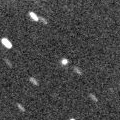
|
Now it is 15.6 mag (Dec. 28, D. Buczynski). It is expected to brighten very rapidly up to 4.5 mag in April. However, it is not observable at the high light. In the Northern Hemisphere, it stays observable until early February when it brightens up to 14 mag. Then it will appear at 6 mag in mid May, and it stays observable in good condition after that while the comet will be fading. In the Southern Hemisphere, it is not observable until August.
Date(TT) R.A. (2000) Decl. Delta r Elong. m1 Best Time(A, h)
Jan. 22 22 37.41 1 19.2 2.585 1.948 40 15.0 18:46 ( 75, 22)
Jan. 29 22 46.71 0 53.9 2.544 1.834 35 14.7 18:52 ( 79, 17)
|
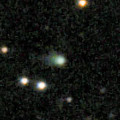
|
Now it is 15.3 mag (Jan. 14, Thomas Lehmann). It is expected to brighten up to 11 mag in 2023. In the Northern Hemisphere, it stays observable in good condition for a long time. It is not observable in the Southern Hemisphere.
Date(TT) R.A. (2000) Decl. Delta r Elong. m1 Best Time(A, h)
Jan. 22 16 41.49 31 59.8 5.428 5.223 72 14.8 5:37 (261, 53)
Jan. 29 16 42.50 32 32.9 5.316 5.182 76 14.8 5:34 (263, 58)
|

|
Now it is 15.8 mag (Oct. 4, Thomas Lehmann). Appearing in the morning. It will brighten up to 13 mag in summer.
Date(TT) R.A. (2000) Decl. Delta r Elong. m1 Best Time(A, h)
Jan. 22 17 15.15 -24 9.7 3.813 3.149 41 14.9 5:37 (311, 12)
Jan. 29 17 25.89 -24 31.2 3.736 3.140 46 14.8 5:34 (314, 14)
|

|
Now it is 15.9 mag (Jan. 2, Thomas Lehmann). It will brighten up to 12.5 mag in summer. In the Southern Hemisphere, it stays observable in excellent condition for a long time. In the Northern Hemisphere, it is not observable until August.
Date(TT) R.A. (2000) Decl. Delta r Elong. m1 Best Time(A, h)
Jan. 22 22 20.42 -60 50.5 4.366 3.758 46 14.9 18:46 ( 29,-20)
Jan. 29 22 22.46 -59 39.2 4.346 3.717 45 14.9 18:52 ( 32,-23)
|
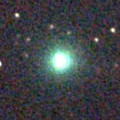
|
It brightened very rapidly, and brightened up to 8.9 mag (Sept. 11, Chris Wyatt). Now it is fading. It has already faded down to 15.7 mag (Dec. 7, E. Cortes, N. Paul, B. Lutkenhoner). In the Southern Hemisphere, it stays observable after this while the comet will be fading. It is not observable after this in the Northern Hemisphere.
Date(TT) R.A. (2000) Decl. Delta r Elong. m1 Best Time(A, h)
Jan. 22 16 49.73 -54 19.8 2.710 2.241 51 15.1 5:37 (334, -8)
Jan. 29 17 4.23 -54 34.1 2.724 2.312 55 15.4 5:34 (336, -8)
|
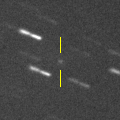
|
Now it is bright as 15.4 mag (Jan. 8, Ken-ichi Kadota. Cometary activity was detected. In the Northern Hemisphere, it is observable only until early March. In the Southern Hemisphere, it is not observable until late May. But it will be observable in good condition after that.
Date(TT) R.A. (2000) Decl. Delta r Elong. m1 Best Time(A, h)
Jan. 22 17 37.50 42 53.7 1.566 1.579 72 15.5 5:37 (242, 44)
Jan. 29 18 24.84 45 59.9 1.484 1.497 71 15.2 5:34 (236, 41)
|
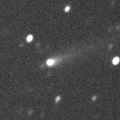
|
It brightened rapidly. Now it is 14.7 mag (Jan. 11, Michael Jager). It stays 15 mag until February, and it is observable in excellent condition.
Date(TT) R.A. (2000) Decl. Delta r Elong. m1 Best Time(A, h)
Jan. 22 8 15.36 14 43.9 1.543 2.525 174 15.2 0:13 ( 0, 70)
Jan. 29 8 9.17 14 27.6 1.558 2.535 170 15.3 23:34 ( 0, 69)
|

|
Now it is 15.9 mag (Oct. 8, Thomas Lehmann). It stays at 14-15 mag for a long time from 2021 to 2022. In the Southern Hemisphere, it stays observable in excellent condition for a long time. In the Northern Hemiphere, it locates extremely low in spring.
Date(TT) R.A. (2000) Decl. Delta r Elong. m1 Best Time(A, h)
Jan. 22 17 12.48 -31 42.0 5.711 5.031 42 15.3 5:37 (317, 7)
Jan. 29 17 15.18 -32 37.1 5.629 5.038 49 15.3 5:34 (321, 9)
|
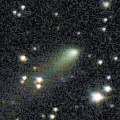
|
Now it is 15.6 mag (Jan. 7, Toshihiko Ikemura, Hirohisa Sato). It will be fading after this. In the Northern Hemisphere, it stays observable in good condition for a long time. It locates low in the Southern Hemisphere.
Date(TT) R.A. (2000) Decl. Delta r Elong. m1 Best Time(A, h)
Jan. 22 16 8.42 24 5.0 2.718 2.631 74 15.4 5:37 (279, 56)
Jan. 29 16 4.32 25 57.6 2.637 2.668 81 15.4 5:34 (282, 63)
|
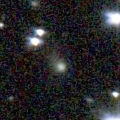
|
Now it is 15.8 mag (Jan. 14, Thomas Lehmann). It is expected to brighten up to 11 mag in 2023. In the Northern Hemisphere, it stays observable in good condition until November. But it becomes unobservable after that. In the Southern Hemisphere, it is not observable until February. But it will be observable in good condition at the high light.
Date(TT) R.A. (2000) Decl. Delta r Elong. m1 Best Time(A, h)
Jan. 22 18 31.06 17 41.2 5.972 5.328 45 15.6 5:37 (265, 24)
Jan. 29 18 35.63 17 29.8 5.892 5.280 47 15.5 5:34 (268, 28)
|
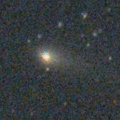
|
It brightened up to 13.1 mag in autumn (Oct. 28, Toshihiko Ikemura, Hirohisa Sato). Now it is fading. But it is bright as 14.2 mag still now (Jan. 1, Toshihiko Ikemura, Hirohisa Sato). It stays observable in good condition for a long time. But it will be fainter than 18 mag in March.
Date(TT) R.A. (2000) Decl. Delta r Elong. m1 Best Time(A, h)
Jan. 22 2 18.43 7 6.9 1.486 1.826 93 15.6 18:46 ( 17, 61)
Jan. 29 2 32.51 8 29.0 1.572 1.852 89 15.9 18:52 ( 27, 61)
|
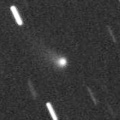
|
Now it is 15.5 mag (Jan. 1, Toshihiko Ikemura, Hirohisa Sato). It stays observable at 15-16 mag for a long time.
Date(TT) R.A. (2000) Decl. Delta r Elong. m1 Best Time(A, h)
Jan. 22 13 2.38 12 45.8 2.885 3.369 111 15.7 4:58 ( 0, 68)
Jan. 29 12 55.03 12 20.6 2.804 3.400 119 15.7 4:24 ( 0, 67)
|
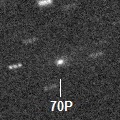
|
Now it is 16.2 mag (Dec. 29, Ken-ichi Kadota). It will brighten up to 15.5 mag, and will be observable in excellent condition in winter.
Date(TT) R.A. (2000) Decl. Delta r Elong. m1 Best Time(A, h)
Jan. 22 11 51.68 7 5.2 1.375 2.110 126 15.8 3:48 ( 0, 62)
Jan. 29 11 53.73 7 32.9 1.332 2.128 132 15.7 3:22 ( 0, 62)
|
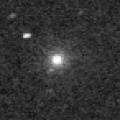
|
It was observed at 9-10 mag from late July to early August. Although it had been unobservable for a long time, it is appearing in the morning sky now.
Date(TT) R.A. (2000) Decl. Delta r Elong. m1 Best Time(A, h)
Jan. 22 16 17.93 -24 57.4 3.134 2.689 54 15.8 5:37 (322, 19)
Jan. 29 16 24.48 -25 48.4 3.129 2.775 60 15.9 5:34 (327, 21)
|
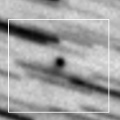
|
Now it is 16.0 mag (Dec. 28, D. Buczynski). It is expected to brighten up to 11 mag in summer. In the Northern Hemisphere, it stays observable in good condition until June when it brightens up to 11 mag. But it is not observable after the high light. In the Souther Hemisphere, it is not observable until October.
Date(TT) R.A. (2000) Decl. Delta r Elong. m1 Best Time(A, h)
Jan. 22 22 58.18 51 3.3 2.939 2.921 79 16.0 18:46 (130, 46)
Jan. 29 23 7.06 50 54.1 2.920 2.842 75 15.9 18:52 (130, 42)
|
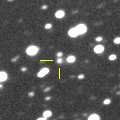
|
First return of a new periodic comet observed at 16 mag from 2003 to 2004. Now it is 16.1 mag (Jan. 3, Toshihiko Ikemura, Hirohisa Sato). It stays 16 mag until March, and it stays observable in excellent condition.
Date(TT) R.A. (2000) Decl. Delta r Elong. m1 Best Time(A, h)
Jan. 22 6 6.45 5 52.4 3.092 3.944 145 15.9 21:59 ( 0, 61)
Jan. 29 6 3.75 6 49.4 3.148 3.947 139 15.9 21:29 ( 0, 62)
|

|
Now it is 16.5 mag (Dec. 19, E. Cortes, B. Lutkenhoner). It will be fading slowly after this. In the Southern Hemisphere, it stays observable in good condition for a long time. In the Northern Hemisphere, it is not observable until July.
Date(TT) R.A. (2000) Decl. Delta r Elong. m1 Best Time(A, h)
Jan. 22 23 38.25 -48 37.2 4.642 4.074 49 16.1 18:46 ( 30, -4)
Jan. 29 23 47.33 -46 47.1 4.710 4.103 47 16.2 18:52 ( 34, -5)
|
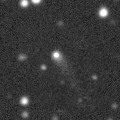
|
Now it is 16.3 mag (Jan. 7, Toshihiko Ikemura, Hirohisa Sato). It stays observable at 16 mag from 2021 to 2022. Appearing in the morning sky also in the Southern Hemisphere.
Date(TT) R.A. (2000) Decl. Delta r Elong. m1 Best Time(A, h)
Jan. 22 15 59.16 13 26.0 5.012 4.787 71 16.2 5:37 (296, 52)
Jan. 29 16 3.75 14 47.3 4.929 4.798 76 16.2 5:34 (300, 57)
|

|
Brightened rapidly. Now it is 16.0 mag (Jan. 1, Toshihiko Ikemura, Hirohisa Sato). It is observable at 15.5-16 mag in good condition in winter.
Date(TT) R.A. (2000) Decl. Delta r Elong. m1 Best Time(A, h)
Jan. 22 2 14.01 11 19.6 3.631 3.819 93 16.2 18:46 ( 22, 65)
Jan. 29 2 18.40 11 29.6 3.739 3.824 87 16.3 18:52 ( 37, 62)
|
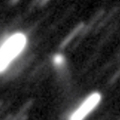
|
It was observed at 15 mag in 2021. Now it is fading. It stays observable at 17 mag for a while in 2022.
Date(TT) R.A. (2000) Decl. Delta r Elong. m1 Best Time(A, h)
Jan. 22 18 10.12 0 10.0 5.750 4.994 36 16.6 5:37 (283, 19)
Jan. 29 18 15.36 1 9.3 5.703 5.007 41 16.6 5:34 (286, 23)
|

|
Now it is 17.7 mag (Jan. 2, J. Drummond). It brightened rapidly. It stays 17 mag for a long time from 2021 to 2022. In the Southern Hemisphere, it stays observable in good condition for a long time. In the Northern Hemisphere, it will be observable only in extremely low sky from autumn to winter.
Date(TT) R.A. (2000) Decl. Delta r Elong. m1 Best Time(A, h)
Jan. 22 7 59.09 -46 34.5 4.887 5.357 113 16.7 23:51 ( 0, 8)
Jan. 29 7 48.51 -47 0.4 4.889 5.362 113 16.7 23:13 ( 0, 8)
|
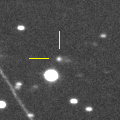
|
Now it is 16.7 mag (Jan. 8, Toshihiko Ikemura, Hirohisa Sato). It will brighten up to 14 mag in early 2023. It stays observable in good condition until spring.
Date(TT) R.A. (2000) Decl. Delta r Elong. m1 Best Time(A, h)
Jan. 22 4 18.70 4 33.3 4.258 4.832 120 16.8 20:12 ( 0, 60)
Jan. 29 4 18.09 5 6.1 4.307 4.790 113 16.8 19:44 ( 0, 60)
|

|
It has not been observed yet in this return. It was predicted to brighten up to 16.5 mag in January. It will fade out rapidly after this.
Date(TT) R.A. (2000) Decl. Delta r Elong. m1 Best Time(A, h)
Jan. 22 23 19.74 -6 45.6 1.608 1.173 46 16.8 18:46 ( 61, 25)
Jan. 29 23 43.98 -2 31.4 1.629 1.191 46 17.1 18:52 ( 66, 27)
|

|
Now it is 16.9 mag (Jan. 8, Toshihiko Ikemura, Hirohisa Sato). Fading slowly. In the Northern Hemisphere, it stays observable in good condition for a long time. In the Southern Hemisphere, it is not observable after this.
Date(TT) R.A. (2000) Decl. Delta r Elong. m1 Best Time(A, h)
Jan. 22 19 0.19 49 6.7 9.285 9.012 70 16.8 5:37 (229, 32)
Jan. 29 19 3.87 49 43.2 9.286 9.020 71 16.8 5:34 (230, 35)
|
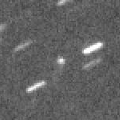
|
Now it is 16.6 mag (Dec. 27, Ken-ichi Kadota). It started fading before the perihelion passage. It was predicted to stay at 16 mag for a long time, but actually, it will be fainter than 18 mag in autumn. In the Northern Hemisphere, it stays observable in good condition for a long time. In the Southern Hemisphere, it is not observable until 2023.
Date(TT) R.A. (2000) Decl. Delta r Elong. m1 Best Time(A, h)
Jan. 22 22 31.77 84 50.7 3.469 3.851 105 16.8 18:46 (174, 37)
Jan. 29 22 48.14 82 49.6 3.512 3.838 101 16.9 18:52 (172, 37)
|
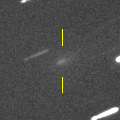
|
First return of a new periodic comet which brightened up to 17 mag in 2011. Now it is 18.2 mag (Jan. 8, Toshihiko Ikemura, Hirohisa Sato). It brightened up to 16.8 mag in October (Oct. 10, Ken-ichi Kadota), however, it has been fading after that.
Date(TT) R.A. (2000) Decl. Delta r Elong. m1 Best Time(A, h)
Jan. 22 14 23.94 -9 45.9 1.393 1.630 84 16.8 5:37 (345, 44)
Jan. 29 14 37.55 -10 55.7 1.355 1.652 88 16.8 5:34 (349, 43)
|
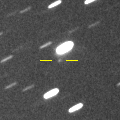
|
Now it is 16.9 mag (Jan. 2, J. Drummond). It is observable at 16.5 mag in good condition from winter to spring.
Date(TT) R.A. (2000) Decl. Delta r Elong. m1 Best Time(A, h)
Jan. 22 10 20.42 -27 47.7 1.675 2.366 123 16.9 2:17 ( 0, 27)
Jan. 29 10 21.28 -26 54.5 1.616 2.366 129 16.9 1:50 ( 0, 28)
|
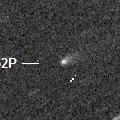
|
Now it is 16.7 mag (Dec. 29, Ken-ichi Kadota). It stays observable at 17 mag from autumn to winter.
Date(TT) R.A. (2000) Decl. Delta r Elong. m1 Best Time(A, h)
Jan. 22 12 50.39 -8 7.2 1.527 2.043 106 16.9 4:46 ( 0, 47)
Jan. 29 12 53.53 -9 16.9 1.483 2.074 112 16.9 4:22 ( 0, 46)
|
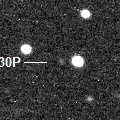
|
Now it is 18.7 mag (Jan. 1, W. Hasubick). It was expected to brighten up to 16.5-17 mag in winter. In its last apparition in 2015, it brightened up to 13 mag. But actually, it is fainter than this ephemeris recently.
Date(TT) R.A. (2000) Decl. Delta r Elong. m1 Best Time(A, h)
Jan. 22 0 9.08 -12 50.0 2.000 1.668 56 16.9 18:46 ( 46, 29)
Jan. 29 0 25.21 -10 32.6 2.023 1.646 53 16.9 18:52 ( 52, 28)
|
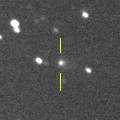
|
Now it is 16.7 mag (Jan. 7, Toshihiko Ikemura, Hirohisa Sato). It continued brightening for a while even after the perihelion passage. It stays observable at 16-17 mag in good condition for a while.
Date(TT) R.A. (2000) Decl. Delta r Elong. m1 Best Time(A, h)
Jan. 22 4 22.44 -10 42.2 3.452 3.970 115 16.9 20:16 ( 0, 44)
Jan. 29 4 22.06 -9 33.6 3.550 3.989 109 17.0 19:48 ( 0, 46)
|
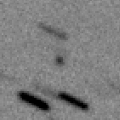
|
Now it is 17.4 mag (Dec. 23, ATLAS-HKO, Haleakala). It is observable at 17 mag from November to March. It is observable in good condition in the Northern Hemisphere, but it locates low in the Southern Hemisphere.
Date(TT) R.A. (2000) Decl. Delta r Elong. m1 Best Time(A, h)
Jan. 22 5 20.92 29 19.4 1.685 2.515 139 17.1 21:14 ( 0, 84)
Jan. 29 5 19.46 29 52.6 1.735 2.504 132 17.2 20:45 ( 0, 85)
|
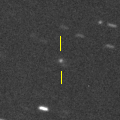
|
Now it is 17.4 mag (Jan. 7, Toshihiko Ikemura, Hirohisa Sato). It will brighten up to 11.5 mag in 2022 winter. It stays observable while the comet will be brightening slowly.
Date(TT) R.A. (2000) Decl. Delta r Elong. m1 Best Time(A, h)
Jan. 22 2 57.74 13 12.6 2.764 3.153 104 17.2 18:52 ( 0, 68)
Jan. 29 2 59.33 13 28.4 2.829 3.116 97 17.2 18:52 ( 17, 68)
|
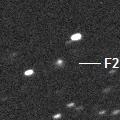
|
Now it is 17.2 mag (Jan. 7, Toshihiko Ikemura, Hirohisa Sato). It stays observable at 17-18 mag for a long time until 2024.
Date(TT) R.A. (2000) Decl. Delta r Elong. m1 Best Time(A, h)
Jan. 22 14 38.59 -4 45.5 8.942 8.875 82 17.2 5:37 (338, 48)
Jan. 29 14 37.73 -4 26.8 8.811 8.871 90 17.2 5:34 (347, 50)
|
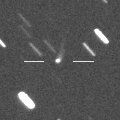
|
Now it is 16.4 mag (Oct. 4, ATLAS-MLO, Mauna Loa). In the Southern Hemisphere, it stays observable for a long time. In the Northern Hemisphere, it is not observable after this.
Date(TT) R.A. (2000) Decl. Delta r Elong. m1 Best Time(A, h)
Jan. 22 11 25.96 -54 45.9 3.632 3.847 95 17.2 3:22 ( 0, 0)
Jan. 29 11 15.15 -54 24.2 3.591 3.896 100 17.3 2:44 ( 0, 0)
|
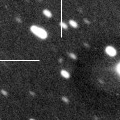
|
Now it is 17.4 mag (Jan. 2, J. Drummond). It will brighten up to 13-14 mag from 2024 to 2025.
Date(TT) R.A. (2000) Decl. Delta r Elong. m1 Best Time(A, h)
Jan. 22 7 22.10 -31 53.5 7.941 8.566 126 17.3 23:15 ( 0, 23)
Jan. 29 7 19.50 -31 46.1 7.911 8.529 126 17.3 22:44 ( 0, 23)
|

|
Now it is 17.8 mag (Jan. 8, Toshihiko Ikemura, Hirohisa Sato). It stays 17-18 mag for a long time from 2021 to 2022. It is observable in excellent condition in the Northern Hemisphere, It locates somewhat low in the Southern Hemisphere.
Date(TT) R.A. (2000) Decl. Delta r Elong. m1 Best Time(A, h)
Jan. 22 2 52.78 29 15.9 5.007 5.383 107 17.4 18:46 ( 0, 84)
Jan. 29 2 48.03 28 42.5 5.131 5.378 99 17.4 18:52 ( 55, 80)
|
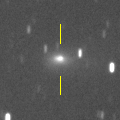
|
It brightened even after the perihelion passage, and it brightened up to 13.5 mag in December (Dec. 6, Katsumi Yoshimoto). Now it is fading. It has already faded down to 16.8 mag (Jan. 8, Toshihiko Ikemura, Hirohisa Sato). It is observable in excellent condition in the Northern Hemisphere. It locates low in the Southern Hemisphere.
Date(TT) R.A. (2000) Decl. Delta r Elong. m1 Best Time(A, h)
Jan. 22 6 44.40 40 49.8 1.178 2.096 151 17.4 22:38 (180, 84)
Jan. 29 6 41.08 40 34.3 1.250 2.134 145 17.7 22:07 (180, 84)
|
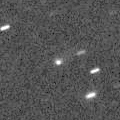
|
Now it is 17.3 mag (Jan. 7, Toshihiko Ikemura, Hirohisa Sato). It will be observable at 17 mag in good condition in spring.
Date(TT) R.A. (2000) Decl. Delta r Elong. m1 Best Time(A, h)
Jan. 22 13 39.69 -9 12.4 4.524 4.716 95 17.4 5:36 ( 0, 46)
Jan. 29 13 41.73 -9 26.1 4.414 4.714 101 17.4 5:10 ( 0, 45)
|
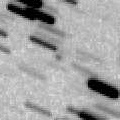
|
Now it is 17.8 mag (Jan. 2, Ken-ichi Kadota). It is expected to brighten up to 13.5 mag from June to July. It is observable only in the Southern Hemisphere at the high light. In the Northern Hemisphere, it is observable only until March when it brightens up to 16.5 mag.
Date(TT) R.A. (2000) Decl. Delta r Elong. m1 Best Time(A, h)
Jan. 22 1 9.89 9 28.8 2.317 2.323 78 17.5 18:46 ( 48, 55)
Jan. 29 1 9.71 7 27.2 2.381 2.247 70 17.4 18:52 ( 57, 48)
|
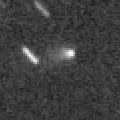
|
Now it is 17.1 mag (Jan. 14, Thomas Lehmann). It was expected to brighten up to 15.5 mag in winter. But actually, it is fading even before the perihelion passage. In the Northern Hemisphere, it stays observable in good condition for a long time. It is not observable at all in the Southern Hemisphere.
Date(TT) R.A. (2000) Decl. Delta r Elong. m1 Best Time(A, h)
Jan. 22 16 44.41 78 48.0 2.571 2.949 102 17.5 5:37 (191, 42)
Jan. 29 16 43.20 82 9.6 2.548 2.947 104 17.5 5:34 (187, 41)
|

|
It has not been observed yet in this apparition. It will be observable at 16 mag in good condition in spring.
Date(TT) R.A. (2000) Decl. Delta r Elong. m1 Best Time(A, h)
Jan. 22 15 9.66 -32 6.6 1.677 1.603 68 17.7 5:37 (340, 20)
Jan. 29 15 34.37 -33 12.9 1.606 1.571 70 17.5 5:34 (341, 19)
|

|
Now it is 17.7 mag (Jan. 1, Toshihiko Ikemura, Hirohisa Sato). In the Northern Hemisphere, it stays observable for a long time while it is getting fainter slowly. In the Southern Hemisphere, it will never be observable again.
Date(TT) R.A. (2000) Decl. Delta r Elong. m1 Best Time(A, h)
Jan. 22 14 54.13 42 32.6 7.427 7.601 96 17.5 5:37 (237, 74)
Jan. 29 14 54.29 43 2.4 7.407 7.649 100 17.5 5:34 (226, 78)
|
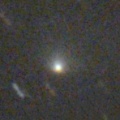
|
It brightened up to 14.5 mag in autumn (Oct. 1, Ken-ichi Kadota). Now it is fading. It has already faded down to 16.4 mag (Jan. 1, Toshihiko Ikemura, Hirohisa Sato). It will be fading rapidly after this. It will be fainter than 18 mag in February.
Date(TT) R.A. (2000) Decl. Delta r Elong. m1 Best Time(A, h)
Jan. 22 0 38.31 -6 23.2 2.714 2.465 65 17.5 18:46 ( 44, 38)
Jan. 29 0 49.00 -5 7.8 2.807 2.482 60 17.6 18:52 ( 51, 36)
|
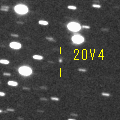
|
Now it is 17.5 mag (Jan. 3, Toshihiko Ikemura, Hirohisa Sato). It is observable at 17.5 mag in good condition in winter.
Date(TT) R.A. (2000) Decl. Delta r Elong. m1 Best Time(A, h)
Jan. 22 7 50.74 3 18.3 4.289 5.236 162 17.5 23:43 ( 0, 58)
Jan. 29 7 47.72 3 31.7 4.307 5.242 159 17.5 23:13 ( 0, 58)
|
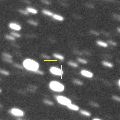
|
Now it is 17.7 mag (Jan. 7, Toshihiko Ikemura, Hirohisa Sato). It will brighten up to 15-16 mag in 2023.
Date(TT) R.A. (2000) Decl. Delta r Elong. m1 Best Time(A, h)
Jan. 22 7 28.18 -24 25.1 4.743 5.476 134 17.6 23:20 ( 0, 31)
Jan. 29 7 18.88 -24 2.8 4.710 5.429 132 17.6 22:43 ( 0, 31)
|
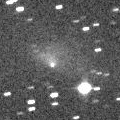
|
It brightened up to 10.1 mag in spring (Apr. 10, Marco Goiato). Now it is fading. It has already faded down to 16.5 mag (Dec. 30, Ken-ichi Kadota). It stays observable in good condition for a long time after this while the comet will fading.
Date(TT) R.A. (2000) Decl. Delta r Elong. m1 Best Time(A, h)
Jan. 22 3 44.15 9 10.8 2.428 2.966 113 17.6 19:38 ( 0, 64)
Jan. 29 3 45.72 9 53.5 2.558 3.004 107 17.8 19:12 ( 0, 65)
|

|
It has not been observed yet in this apparition. It is expected to brighten up to 11 mag from summer to autumn. It stays observable in good condition in the Southern Hemisphere. In the Northern Hemisphere, it becomes extremely low from August to September.
Date(TT) R.A. (2000) Decl. Delta r Elong. m1 Best Time(A, h)
Jan. 22 11 7.53 23 3.7 1.800 2.631 139 17.9 3:04 ( 0, 78)
Jan. 29 11 4.55 24 11.3 1.694 2.576 146 17.6 2:34 ( 0, 79)
|
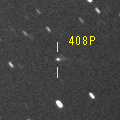
|
It brightened very rapidly. Now it is 17.8 mag (Jan. 3, Purple Mountain Observatory, XuYi Station). It will brighten up to 16 mag, and it will be observable in good condition in 2022 winter.
Date(TT) R.A. (2000) Decl. Delta r Elong. m1 Best Time(A, h)
Jan. 22 0 2.29 -1 4.8 4.088 3.671 58 17.7 18:46 ( 57, 37)
Jan. 29 0 9.32 -0 37.8 4.165 3.660 53 17.7 18:52 ( 63, 32)
|
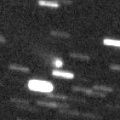
|
It was observed at 16 mag from 2020 to 2021. Now it is fading. It will be fainter than 18 mag in spring.
Date(TT) R.A. (2000) Decl. Delta r Elong. m1 Best Time(A, h)
Jan. 22 15 42.39 -35 16.0 6.196 5.788 61 17.7 5:37 (335, 14)
Jan. 29 15 42.06 -36 0.8 6.115 5.820 68 17.7 5:34 (340, 15)
|
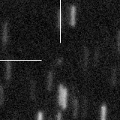
|
Now it is 17.5 mag (Jan. 1, H. Nohara). It is expected to brighten up to 12 mag from winter to summer in 2023. In the Northern Hemisphere, it stays observable in good condition until 2023 spring. In the Southern Hemisphere, it is not observable until summer.
Date(TT) R.A. (2000) Decl. Delta r Elong. m1 Best Time(A, h)
Jan. 22 1 27.02 51 9.8 5.074 5.302 98 17.8 18:46 (143, 68)
Jan. 29 1 30.38 49 58.4 5.108 5.244 92 17.7 18:52 (135, 64)
|

|
It brightened up to 11.6 mag in last winter (Feb. 18, Thomas Lehmann). Now it is fading. It has already faded down to 16.6 mag (Nov. 23, Thomas Lehmann). In the Southern Hemisphere, it stays observable in good condition after this. In the Northern Hemisphere, it will never be observable after this.
Date(TT) R.A. (2000) Decl. Delta r Elong. m1 Best Time(A, h)
Jan. 22 1 7.31 -51 9.1 5.331 4.981 64 17.9 18:46 ( 16, 1)
Jan. 29 1 9.53 -49 34.1 5.446 5.043 60 18.0 18:52 ( 21, 0)
|

|
First return of a new periodic comet which brightened up to 16.5 mag in 1997. Now it is 19.4 mag (Jan. 11, Purple Mountain Observatory, XuYi Station). It is fainter than originally predicted by 2 mag. It is observable in good condition from January to March.
Date(TT) R.A. (2000) Decl. Delta r Elong. m1 Best Time(A, h)
Jan. 22 8 44.72 27 58.2 1.196 2.171 169 19.8 0:42 ( 0, 83)
Jan. 29 8 39.82 27 18.9 1.171 2.149 170 19.7 0:09 ( 0, 82)
|
|
![]()
 C/2019 O3 ( Palomar )
C/2019 O3 ( Palomar ) C/2020 U5 ( PanSTARRS )
C/2020 U5 ( PanSTARRS ) 430P/2021 Q2 ( Scotti )
430P/2021 Q2 ( Scotti ) C/2021 U5 ( Catalina )
C/2021 U5 ( Catalina ) 52P/Harrington-Abell
52P/Harrington-Abell 230P/LINEAR
230P/LINEAR 254P/McNaught
254P/McNaught 274P/Tombaugh-Tenagra
274P/Tombaugh-Tenagra 81P/Wild 2
81P/Wild 2 C/2020 F2 ( ATLAS )
C/2020 F2 ( ATLAS ) C/2019 T2 ( Lemmon )
C/2019 T2 ( Lemmon ) C/2021 G2 ( ATLAS )
C/2021 G2 ( ATLAS ) C/2020 U4 ( PanSTARRS )
C/2020 U4 ( PanSTARRS ) 108P/Ciffreo
108P/Ciffreo 99P/Kowal 1
99P/Kowal 1 C/2021 T2 ( Fuls )
C/2021 T2 ( Fuls ) C/2021 D2 ( ZTF )
C/2021 D2 ( ZTF ) 325P/Yang-Gao
325P/Yang-Gao C/2018 N2 ( ASASSN )
C/2018 N2 ( ASASSN ) 284P/McNaught
284P/McNaught P/2020 V4 ( Rankin )
P/2020 V4 ( Rankin ) A/2021 X1
A/2021 X1 10P/Tempel 2
10P/Tempel 2 73P/Schwassmann-Wachmann 3
73P/Schwassmann-Wachmann 3 408P/2020 M7 ( Novichonok-Gerke )
408P/2020 M7 ( Novichonok-Gerke ) C/2017 Y2 ( PanSTARRS )
C/2017 Y2 ( PanSTARRS ) C/2021 Y1 ( ATLAS )
C/2021 Y1 ( ATLAS ) C/2019 N1 ( ATLAS )
C/2019 N1 ( ATLAS ) P/2021 W2 ( Kobayashi )
P/2021 W2 ( Kobayashi )![]()


































































